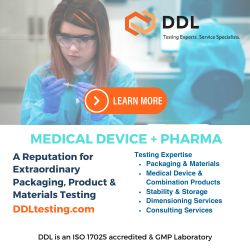Bio Platforms
Medicus Pharma Announces Engagement With Reliant AI to Develop AI-Driven Clinical Data Analytics Platform
Medicus Pharma Ltd. recently announced it has entered into non-binding letter of intent (LOI) with Reliant AI Inc., a decision-intelligence company for the life sciences, specializing in…
Nimbus Therapeutics Announces Completion of Dose Escalation in Phase 1/2 Clinical Trial of a Novel WRN Inhibitor for MSI-H Tumors
Nimbus Therapeutics, LLC recently announced the completion of dose escalation (Part A) in its Phase 1/2 clinical trial of NDI-219216, the company’s investigational non-covalent Werner…
MediciNova Announces Completion of Patient Enrollment Evaluating MN-166 in the Prevention of Chemotherapy-Induced Peripheral Neuropathy
MediciNova, Inc. recently announced the successful completion of patient enrollment in the randomized, placebo-controlled Phase 2 clinical trial, the OXTOX study (Oxaliplatin Neurotoxicity study in…
Brainomix AI Technology Reveals Efficacy of Novel Neuroprotective Drug Candidate in Severe Acute Ischemic Stroke Patients
Brainomix recently announced results from its partnership with Argenica Therapeutics for imaging and clinical data analysis of the Phase II trial evaluating ARG-007, a neuroprotective…
PADCEV Plus Keytruda Significantly Improves Survival for Patients With Muscle-Invasive Bladder Cancer Regardless of Cisplatin Eligibility
Astellas Pharma Inc. and Pfizer Inc. recently announced positive topline results from an interim analysis of the Phase 3 EV-304 clinical trial (also known as…
Affibody Accelerates Phase 1 Study with ABY-271 Following Initial Patient Data
Affibody AB recently announced the Trial Review Committee (TRC) has recommended to advance the Phase I clinical study with the Radioligand Therapy (RLT) candidate ABY-271…
Medicus Pharma Completes Enrollment of 90 Patients for Phase 2 Clinical Study to Non-Invasively Treat Basal Cell Carcinoma of the Skin
Medicus Pharma Ltd. recently announced its Phase 2 clinical study (SKNJCT-003) evaluating safety and efficacy of Doxorubicin Microneedle Array (D-MNA) to non-invasively treat nodular basal…
2026 COMPANY PROFILES & CAPABILITIES
For each participating company, this section presents a detailed summary highlighting their core technologies, capabilities, technologies, and services.
PLATFORM TECHNOLOGY - Developing Innovative Solutions to One of the Top Public Health Threats: Antibacterial Resistance
Jennifer Schneider, PhD, believes immunotherapy holds the potential to revolutionize the treatment of “hard to treat,” chronic, and often recalcitrant infections.
Spinogenix Reports Evidence of Rapid, Sustained Cognitive Improvement in Alzheimer’s Patients From Phase 2a Trial of TAZBENTETOL
Spinogenix, Inc. recently announced encouraging results from its completed Phase 2a trial evaluating Tazbentetol (formerly named SPG302) for the treatment of Alzheimer’s disease (AD). Once-daily…
Kelun-Biotech & Crescent Biopharma Announce Strategic Partnership to Develop & Commercialize Novel Oncology Therapeutics
Sichuan Kelun-Biotech Biopharmaceutical Co., Ltd. and Crescent Biopharma, Inc. recently announced they have entered into a strategic partnership to develop and commercialize oncology therapeutics, including…
Protara Therapeutics Announces Updated Interim Data from Phase 2 ADVANCED-2 Trial of TARA-002 in BCG-Naïve NMIBC Patients
Protara Therapeutics, Inc. recently announced updated interim data from the ongoing Phase 2 open-label ADVANCED-2 trial of TARA-002 in patients with carcinoma in situ or…
NorthX Biologics Achieves Milestone GMP Certification to Manufacture Mendus’ Lead Cell Therapy Product for Acute & Chronic Myeloid Leukemias
NorthX Biologics and Mendus recently announced the successful completion of GMP manufacturing certification for Mendus’ lead cell therapy product, vididencel. This milestone marks the culmination…
Azalea Therapeutics Presents New Preclinical Data Demonstrating Robust In Vivo Generation of TRAC-CAR T Cells Using Enveloped Delivery Vehicles
Azalea Therapeutics, Inc. recently announced new preclinical data demonstrating robust in vivo generation of functional TRAC-CAR T cells using its proprietary Enveloped Delivery Vehicle (EDV) technology.…
Oncotelic Achieves Breakthrough $1.7 Billion Pipeline Valuation Through GMP Bio Joint Venture
Oncotelic Therapeutics, Inc. recently announced its joint venture partner, GMP Bio, has completed an independent third-party valuation of its drug development pipeline. The preliminary valuation,…
Protara Therapeutics Announces Positive Interim Results Demonstrating Robust Responses in the Ongoing Phase 2 STARBORN-1 Trial of TARA-002 in Pediatric Patients With Lymphatic Malformations
Protara Therapeutics, Inc. recently announced positive interim results from its ongoing Phase 2 open-label STARBORN-1 trial assessing intracystic injection of TARA-002, the Company’s investigational cell-based therapy,…
Agomab Announces Positive Topline Phase 2a Data for Ontunisertib in Fibrostenosing Crohn’s Disease
Agomab Therapeutics NV recently announced positive data from 103 participants completing 12 weeks of treatment in the STENOVA1 Phase 2a clinical trial for ontunisertib (AGMB-129),…
One-carbon Therapeutics AB Announces First Subject Dosed in the ODIN Phase 1/2 Clinical Study of TH9619 in Advanced Solid Tumors
One-carbon Therapeutics AB recently announced the first subject has been successfully dosed in its ODIN Phase 1/2 clinical trial (NCT07151040) evaluating TH9619, a first-in-class MTHFD1/2…
Adagene Announces Licensing Agreement With Third Arc Bio for Development of Two Masked CD3 T Cell Engagers Utilizing SAFEbody Technology
Adagene Inc. and Third Arc Bio, Inc. recently announced a licensing agreement under which Third Arc Bio will utilize Adagene’s SAFEbody technology platform to generate…
HCW Biologics Presents Preclinical Data for TRBC-Based T-Cell Engager Program
HCW Biologics Inc. recently announced the data presented for their tetra-valent, second-generation T-Cell Engager (“TCE”) Program based on their novel TRBC platform technology, at the…
What are Bio Platforms?
Platforms (or asset-independent technologies to capture all kinds of capabilities that can be leveraged across many different drug candidate assets rather than just discovery tools that the term ‘platform’ immediately brings to mind) are ubiquitous in modern pharma. They are the product of an arms race, to secure access to the best capabilities in key areas.
Platform technologies are considered a valuable tool to improve efficiency and quality in drug product development. The basic idea is that a platform, in combination with a risk-based approach, is the most systematic method to leverage prior knowledge for a given new molecule. Furthermore, such a platform enables a continuous improvement by adding data for every new molecule developed by this approach, increasing the robustness of the platform.
But it has often been said that access to the latest technological platforms to aid efficient drug discovery and development is limited to Big Pharma, which can more easily justify the costs of creating and operating these platforms.
Benefits of Bio Platforms
Platform technologies have the ability to radically improve upon current products and generate completely novel products. In this sense, they open up new arenas for drug discovery and development, potentially increasing the number of therapeutic options for patients. Once a single compound or therapeutic has been generated and demonstrates a clinical benefit in patients, it is more likely this platform technology can successfully be applied to other therapeutic areas, derisking future compounds/products.
Complex drugs by their very nature are challenging and costly to manufacture. This, in turn, translates into higher costs for patients and other payers. In order to provide safe and effective therapies at a reasonable price, it is necessary for the industry to develop manufacturing technologies that reduce costs and provide a consistent product. While the initial investment may be larger, manufacturing costs will be lower over time as the manufacturing process is solidified.
Scale and Investment of Bio Platforms
Despite the initial upfront costs, platform technologies inevitably provide pragmatic solutions to production challenges, while yielding safer and more effective therapeutic products. It has often been said that one of the key features that distinguishes “Big Pharma” from biotech is access to the latest technological platforms to aid efficient drug discovery and development.
These platforms range from vast chemical libraries, ultra-high throughput screening and huge genetic databases in discovery, to predictive toxicology platforms, cutting-edge ‘omics’ and even deep-seated knowledge of particular therapeutic areas in development. All these platforms have two things in common: They can be used on any (or many) development candidate assets, and they cost huge sums to establish in the first place, and in a few cases each time they are used as well. Hence their restriction to the largest pharmaceutical companies (and a few of the so-called “big biotechs” that are, in many ways, indistinguishable from the old-guard pharma).
Only when you have hundreds of active projects can you justify the cost of creating and operating these platforms. Or so the mantra goes. It is access to these platforms that keeps the big companies ahead in the race to discover and develop the best medicines (or at least counterbalance the disadvantages of being large and slow-moving, depending on your point of view). But is that just an assertion? How much evidence is there to support the proposition that the efficiency gains due to these platforms outstrips the cost of creating and maintaining them?
Keeping these technologies “cutting edge” has become so expensive that increasingly we hear pharma companies talking of “pre-competitive” approaches to develop the next generation. A group of companies might develop a platform capability they then share. The principle goal of such initiatives is to access even grander and more expensive tools than individual companies could afford, rather than to dramatically cut costs (although sharing platforms rather than developing the same thing in parallel in each silo should at least keep a lid on rising costs).













